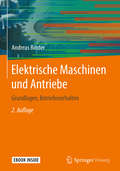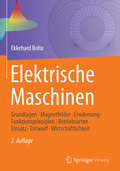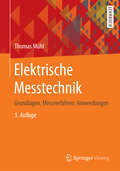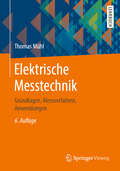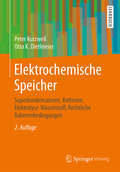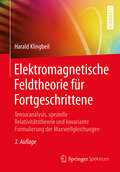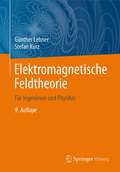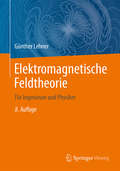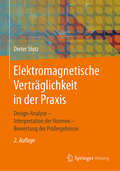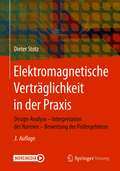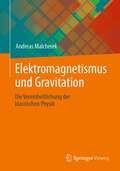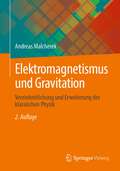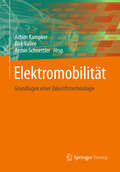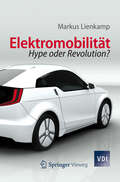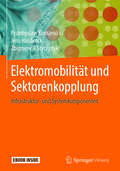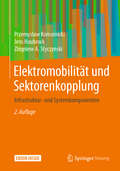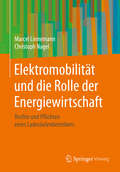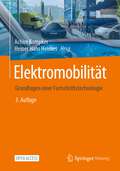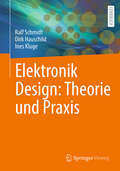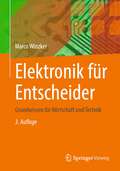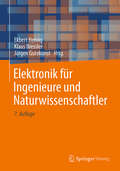- Table View
- List View
Elektrische Maschinen und Antriebe: Grundlagen, Betriebsverhalten
by Andreas BinderDas Buch führt in einem weiten Bogen von den physikalischen Grundlagen zum Verständnis des stationären und des dynamischen Betriebsverhaltens elektrischer Maschinen und Antriebe. Besonderes Augenmerk wird auf die aktuellen Motorentwicklungen gelegt. Dazu werden die Grundlagen elektrischer Maschinen anhand der drei Grundtypen Asynchronmaschine, Synchronmaschine und Gleichstrommaschine ausführlich besprochen, Bauweisen werden erläutert, und das stationäre Betriebsverhalten wird hergeleitet.Neben der anschaulichen Beschreibung anhand modern ausgeführter Maschinen wird die mathematisch fundierte Grundlage von Anfang an mitentwickelt. Bewusst wird die Drehstromtechnik in den Vordergrund gestellt, da sie die klassische Gleichstromtechnik immer weiter in Nischen verdrängt. Aktuelle Motorentwicklungen vor allem im Zusammenhang mit Umrichterspeisung werden ausführlich besprochen. Auch auf Sonderprobleme wie zusätzliche Verluste und Geräusche bei Umrichterspeisung wird ausführlich eingegangen.An die stationäre Theorie schließt sich im zweiten Teil die dynamische Theorie für alle drei Grundtypen von E-Maschinen an, so dass Anlaufvorgänge, plötzliche Kurzschlüsse oder Lastwechsel verstanden werden.Jedes Kapitel enthält durchgerechnete Praxisbeispiele, die oft mit Messergebnissen unterlegt sind. Die Beispiele reichen von Netz- und Umrichter gespeisten Motoren bis hin zu Großgeneratoren im Kraftwerksbereich.In der zweiten Auflage wurden einige Textpassagen überarbeitet und an manchen Stellen nötige Korrekturen durchgeführt, aber der Inhalt im Wesentlichen beibehalten.Eine Aufgabensammlung mit durchgerechneten Anwendungsbeispielen desselben Autors erscheint in einer erweiterten zweiten Auflage als gesonderter Band.Die Zielgruppen Ingenieurinnen, Ingenieure und Studierende der Fachrichtungen „Elektrotechnik“, „Mechatronik“, „Antriebstechnik“, „Energietechnik“ und „Maschinenbau“
Elektrische Maschinen: Grundlagen Magnetfelder, Wicklungen, Asynchronmaschinen, Synchronmaschinen, Elektronisch Kommutierte Gleichstrommaschinen
by Ekkehard BolteMotoren, Generatoren und Aktuatoren sind immer häufiger Schlüsselkomponenten in komplexen Systemen. Ihre Wirkungsweise zu kennen, ist daher für Hersteller und Nutzer von vitalem Interesse. Aufbauend auf den physikalischen Grundlagen werden in dem Band die Zusammenhänge des Fachgebiets herausgearbeitet – unter Berücksichtigung neuer Technologien wie u. a. Echtzeitsignalerfassung oder integrierte Leistungshalbleitermodule. Leser lernen, mithilfe von CAE-Programmen Elektromotoren für spezielle Anwendungen zu entwickeln und zu analysieren.
Elektrische Messtechnik
by Thomas MühlDieses Lehrbuch vermittelt die Grundlagen und Verfahrensweisen der elektrischen Messtechnik zusammen mit ihrer praxisorientierten Anwendung. Nach einer Einführung in messtechnische Begriffe und grundlegende Beschreibungen elektrischer Messgeräte werden die Messprinzipien sowie die analogen und digitalen Verfahren zur Messung der wichtigsten elektrischen Größen erläutert. Schwerpunkte sind die Möglichkeiten und Einsatzbereiche aktueller Messsysteme sowie deren spezifische Besonderheiten. Das Buch deckt die wesentlichen Inhalte einer Vorlesung über die elektrische Messtechnik ab, wie sie Studierende der Elektrotechnik hören. Die fünfte Auflage ist aktualisiert und in einigen Kapiteln wie der Leistungsmessung erweitert.
Elektrische Messtechnik: Grundlagen, Messverfahren, Anwendungen
by Thomas MühlDieses Lehrbuch vermittelt die Grundlagen und Verfahrensweisen der elektrischen Messtechnik zusammen mit ihrer praxisorientierten Anwendung. Nach einer Einführung in messtechnische Begriffe und grundlegende Beschreibungen elektrischer Messgeräte werden die Messprinzipien sowie die analogen und digitalen Verfahren zur Messung der wichtigsten elektrischen Größen erläutert. Schwerpunkte sind die Möglichkeiten und Einsatzbereiche aktueller Messsysteme sowie deren spezifische Besonderheiten. Das Buch deckt die wesentlichen Inhalte einer Vorlesung über die elektrische Messtechnik ab, wie sie Studierende der Elektrotechnik hören. Die fünfte Auflage ist aktualisiert und in einigen Kapiteln wie der Leistungsmessung erweitert.
Elektroakustik: Mikrofone, Klangstufen, Verstärker, Filterschaltungen und Lautsprecher
by Herbert BernsteinDieses Buch bietet eine Zusammenfassung von physikalischen und elektronischen Zusammenhängen der Akustik. Zunächst behandelt es ausführlich die Grundlagen der Akustik. Auf dieser Basis beschreibt der Autor Mikrofone und Vorverstärker. Die Berechnung von aktiven und passiven Filterschaltungen sowie die Vorstellung der verschiedenen Betriebsarten von NF-Leistungsverstärkern vermitteln die notwendigen Kenntnisse der Elektronik. Darauf aufbauend folgen die Beschreibung und Berechnungen von aktiven und passiven Frequenzweichen. Die Beschreibung und Berechnungen von Lautsprecherkombinationen runden das inhaltliche Konzept des Buches ab und ermöglichen dem Leser somit die Einarbeitung in den ganzen Bereich der Elektroakustik.
Elektrochemische Speicher: Superkondensatoren, Batterien, Elektrolyse-Wasserstoff, Rechtliche Rahmenbedingungen
by Peter Kurzweil Otto K. DietlmeierDieses praxisnahe Lehrbuch und Nachschlagewerk zeigt anschaulich die Welt der elektrochemischen Energiewandler und ihre modernen Anwendungen für nachhaltige Energiekonzepte. Wie speichert man überschüssige Wind- und Solarenergie, wie lässt sich Wasserstoff aus nicht-fossilen Ressourcen als chemische Speicherform nutzen? Jeder Themenbereich behandelt die physikalischen, chemischen, ingenieurtechnischen und materialwissenschaftlichen Grundlagen und erlaubt so eine interdisziplinäre Sicht auf die technischen Anwendungen. Eine Übersicht über die rechtlichen Rahmenbedingungen gibt verlässliche Informationen zu rechtlichen Fragestellungen. Für die zweite Auflage wurden zahlreiche Leserzuschriften berücksichtigt und dabei viele Kapitel überarbeitet und erweitert. Die rechtlichen Grundlagen wurden gründlich nach dem Stand der Gesetzgebung im März 2018 aktualisiert.
Elektromagnetische Feldtheorie für Fortgeschrittene: Tensoranalysis, spezielle Relativitätstheorie und kovariante Formulierung der Maxwellgleichungen
by Harald KlingbeilDieses Buch bietet einen behutsamen Einstieg in die Tensoranalysis, in die Grundlagen der speziellen Relativitätstheorie und in die relativistische Formulierung der Elektrodynamik. Die Maxwell’schen Gleichungen im Vakuum und die kovariante Form der Maxwellgleichungen werden intensiv behandelt. Auch Dipole und die Abstrahlung elektromagnetischer Wellen bilden inhaltliche Schwerpunkte.Mathematisch präzise und durch ausführliche Rechnungen leicht verständlich, stellt das Buch eine Verbindung zwischen Elektrotechnik, Mathematik und Physik her. Für diesen Vertiefungsband ist ein Grundwissen der Elektrodynamik hilfreich, wie es im Band „Grundlagen der elektromagnetischen Feldtheorie — Maxwellgleichungen, Lösungsmethoden und Anwendungen“ des Autors oder vergleichbaren Lehrbüchern vermittelt wird.Übungsaufgaben mit ausführlichen Musterlösungen vertiefen den Stoff und helfen bei der Kontrolle des Lernerfolgs. Ein umfangreicher Tabellenteil am Ende des Buchs erlaubt die Nutzung als Nachschlagewerk.
Elektromagnetische Feldtheorie: Für Ingenieure und Physiker
by Günther Lehner Stefan KurzDie elektromagnetische Feldtheorie ist ein für Ingenieure und Naturwissenschaftler grundlegendes Wissensgebiet, das die Gesetzmäßigkeiten elektrischer und magnetischer Felder und Wellen beschreibt. In diesem didaktisch ausgearbeiteten Lehrbuch werden die elektromagnetische Feldtheorie und die dafür erforderlichen mathematischen Methoden vermittelt. Dafür hat der Autor die Lehrinhalte möglichst anschaulich aufbereitet, die Begriffsbildungen und Ableitungen legt er äußerst genau dar.Zu Beginn werden die Maxwellschen Gleichungen, die die Grundlage der klassischen Elektrodynamik bilden, vorgestellt und erläutert. Es folgen Ausführungen über Elektrostatik, Strömungsprobleme, Magnetostatik, quasistationäre Felder und elektromagnetische Wellen. Der Autor behandelt die Anwendung numerischer Methoden wie finite Differenzen, finite Elemente (FEM), Randelemente, Ersatzladungsmethoden und Monte-Carlo-Methoden auf feldtheoretische Probleme. Darüber hinaus gibt er immer wieder Ausblicke auf grundlegende, zum Teil noch offene Fragen der Physik bis hin zur Quantenmechanik. Ein Kapitel widmet sich der Relativitätstheorie, die Maxwells klassische Elektrodynamik erweitert. Denn mithilfe von Einsteins Theorie lassen sich zahlreiche Probleme der elektromagnetischen Feldtheorie leichter lösen.Das Lehrbuch richtet sich an Studierende der ingenieurwissenschaftlichen Fächer und der Physik. Aber auch Studierende anderer naturwissenschaftlicher Fachrichtungen profitieren von diesem Standardwerk zur elektromagnetischen Feldtheorie. Ein Verzeichnis der Symbole und ein Sachverzeichnis erleichtern die Handhabung des Buchs und unterstützen das Lernen.
Elektromagnetische Feldtheorie: für Ingenieure und Physiker
by Günther Lehner Stefan KurzDie elektromagnetische Feldtheorie ist ein für Ingenieure und Naturwissenschaftler grundlegendes Wissensgebiet, das die Gesetzmäßigkeiten elektrischer und magnetischer Felder und Wellen beschreibt. In diesem didaktisch ausgearbeiteten Lehrbuch werden die elektromagnetische Feldtheorie und die dafür erforderlichen mathematischen Methoden vermittelt. Dafür hat der Autor die Lehrinhalte möglichst anschaulich aufbereitet, die Begriffsbildungen und Ableitungen legt er äußerst genau dar.Zu Beginn werden die Maxwellschen Gleichungen, die die Grundlage der klassischen Elektrodynamik bilden, vorgestellt und erläutert. Es folgen Ausführungen über Elektrostatik, Strömungsprobleme, Magnetostatik, quasistationäre Felder und elektromagnetische Wellen. Der Autor behandelt die Anwendung numerischer Methoden wie finite Differenzen, finite Elemente (FEM), Randelemente, Ersatzladungsmethoden und Monte-Carlo-Methoden auf feldtheoretische Probleme. Darüber hinaus gibt er immer wieder Ausblicke auf grundlegende, zum Teil noch offene Fragen der Physik bis hin zur Quantenmechanik. Ein Kapitel widmet sich der Relativitätstheorie, die Maxwells klassische Elektrodynamik erweitert. Denn mithilfe von Einsteins Theorie lassen sich zahlreiche Probleme der elektromagnetischen Feldtheorie leichter lösen. Das Lehrbuch richtet sich an Studierende der ingenieurwissenschaftlichen Fächer und der Physik. Aber auch Studierende anderer naturwissenschaftlicher Fachrichtungen profitieren von diesem Standardwerk zur elektromagnetischen Feldtheorie. Ein Verzeichnis der Symbole und ein Sachverzeichnis erleichtern die Handhabung des Buchs und unterstützen das Lernen.
Elektromagnetische Verträglichkeit in der Praxis
by Dieter StotzDieser Praxis-Ratgeber versucht, dem Leser ein intuitives Gespür für elektromagnetisch verträgliche Produktentwicklung zu vermitteln. Im Zentrum der Betrachtung liegt die Praxis: Analyse von Verträglichkeitsproblemen, Beseitigung und Vermeidung. Der Autor stellt die Grundlagen der elektromagnetischen Verträglichkeit einfach und verständlich dar und entwickelt klare Bewertungskriterien für Testmessungen und Analysen. Im Detail wird dargelegt, welche Schritte beim Entwurf zu beachten sind, wie sich externe Störungen fortpflanzen und wie man die Auswirkungen verhindern kann. Der Autor behandelt auch die Messung und Bewertung von EMV-Störungen, auf mehreren Ebenen: entwicklungsbegleitend (Prototypen Test), mit genormten Mitteln und im akkreditierten Testhaus.
Elektromagnetische Verträglichkeit in der Praxis: Design-Analyse - Interpretation der Normen - Bewertung der Prüfergebnisse
by Dieter StotzDieser Praxis-Ratgeber vermittelt dem Leser ein intuitives Gespür für die elektromagnetisch verträgliche Produktentwicklung. Im Zentrum der Betrachtung liegt die Praxis: Analyse von Verträglichkeitsproblemen, Beseitigung und Vermeidung. Der Autor stellt die Grundlagen der elektromagnetischen Verträglichkeit einfach und verständlich dar und entwickelt klare Bewertungskriterien für Testmessungen und Analysen. Im Detail wird dargelegt, welche Schritte beim Entwurf zu beachten sind, wie sich externe Störungen fortpflanzen und wie man die Auswirkungen verhindern kann. Der Autor behandelt auch die Messung und Bewertung von EMV-Störungen auf mehreren Ebenen: Entwicklungsbegleitend (Prototypen-Test), mit genormten Mitteln und im akkreditierten Testhaus. Berücksichtigung findet auch die seit 2016 erforderliche Risikoanalyse und –bewertung, die der Hersteller für jedes Gerät bereithalten muss. Welchen Sinn hat diese und wie hat sie auszusehen? Solche Fragen beantwortet das vorliegende Buch.
Elektromagnetische Verträglichkeit in der Praxis: Design-Analyse - Interpretation der Normen - Bewertung der Prüfergebnisse
by Dieter StotzDieser Praxis-Ratgeber vermittelt dem Leser ein intuitives Gespür für die elektromagnetisch verträgliche Produktentwicklung. Im Zentrum der Betrachtung liegt die Praxis: Analyse von Verträglichkeitsproblemen, Beseitigung und Vermeidung. Der Autor stellt die Grundlagen der elektromagnetischen Verträglichkeit einfach und verständlich dar und entwickelt klare Bewertungskriterien für Testmessungen und Analysen. Im Detail wird dargelegt, welche Schritte beim Entwurf zu beachten sind, wie sich externe Störungen fortpflanzen und wie man die Auswirkungen verhindern kann. Der Autor behandelt auch die Messung und Bewertung von EMV-Störungen auf mehreren Ebenen: Entwicklungsbegleitend (Prototypen-Test), mit genormten Mitteln und im akkreditierten Testhaus. Berücksichtigung findet auch die seit 2016 erforderliche Risikoanalyse und –bewertung, die der Hersteller für jedes Gerät bereithalten muss. Welchen Sinn hat diese und wie hat sie auszusehen? Solche Fragen beantwortet das vorliegende Buch. Diverse reale Praxisfälle runden den lehrreichen Inhalt ab.
Elektromagnetismus und Gravitation: Die Vereinheitlichung der klassischen Physik
by Andreas MalcherekElektromagnetismus und Gravitation scheinen zwei vollkommen unterschiedliche Wechselwirkungen zu sein: Während elektromagnetische Wechselwirkungen durch Felder beschrieben werden, soll die Gravitation durch eine Krümmung der Raumzeit vermittelt werden. Die Theorie der Elektrogravitation vereinheitlicht die formale Beschreibung dieser beiden Wechselwirkungen. Damit stellt sich natürlich die grundlegende Frage, ob man aus einem einheitlichten Formalismus auch auf einheitliche Wirkmechanismen in der Natur schließen kann. Das Lehrbuch entwickelt die Theorie der Elektrogravitation aus einfachen Prinzipien der speziellen Relativitätstheorie. Darauf aufbauend werden das Newtonsche Gravitationsgesetz, das Coulombsche und das Biot-Savartsche Gesetz sowie die Maxwellschen Gleichungen hergeleitet.
Elektromagnetismus und Gravitation: Vereinheitlichung und Erweiterung der klassischen Physik
by Andreas MalcherekElektromagnetismus und Gravitation scheinen zwei vollkommen unterschiedliche Wechselwirkungen zu sein: Während elektromagnetische Wechselwirkungen durch Felder beschrieben werden, soll die Gravitation durch eine Krümmung der Raumzeit vermittelt werden. Die Theorie der Elektrogravitation vereinheitlicht die formale Beschreibung dieser beiden Wechselwirkungen. Damit stellt sich natürlich die grundlegende Frage, ob man aus einem einheitlichten Formalismus auch auf einheitliche Wirkmechanismen in der Natur schließen kann. Das Lehrbuch entwickelt die Theorie der Elektrogravitation aus einfachen Prinzipien der speziellen Relativitätstheorie. Darauf aufbauend werden allgemeine Gesetze für das Gravitationspotential und die Bewegung in demselben aufgestellt, die die Newtonsche Gravitationstheorie in Richtung allgemeiner Relativitätstheorie verallgemeinern. Mit den formal gleichen Ansätzen werden in der Elektrodynamik das Coulombsche Gesetz sowie die Maxwellschen Gleichungen hergeleitet. Abschließend werden retardierte Potentiale und die Grundlagen der Magnetohydrodynamik vermittelt.
Elektromobilität
by Achim Kampker Armin Schnettler Dirk ValléeDas Buch gibt einen umfassenden Überblick über die Herausforderungen und Lösungen zum Thema Elektromobilität. Von Gestaltungshinweisen bei der Konstruktion des Antriebsstrangs bis hin zu Ansätzen zum Aufbau der Infrastruktur wird ein breites Feld an Themen beleuchtet. Das Buch gliedert sich in fünf Kapitel. In einem Grundlagenkapitel werden die Herausforderungen der Elektromobilität sowie der Ansatz einer integrierten Produkt-, Prozess- und Infrastrukturentwicklung skizziert. Im Kapitel Elektromobilproduktion wird der Prozess der Industrialisierung eines Produktes und die Produktion der Antriebskomponenten dargestellt. Ansätze des Innovationsmanagements und das Thema wirtschaftlicher Leichtbau finden sich im Kapitel Automotive Engineering wieder. Das Kapitel Infrastruktur beinhaltet die Konzepte zum Aufbau eines Servicenetzes und beim Städtebau. Die notwendigen Rechtsgrundlagen und Strategien zur Geschäftsmodellentwicklung werden im Kapitel Business Conception erläutert.
Elektromobilität
by Markus LienkampDas wachsende Bedürfnis nach Mobilität in der Bevölkerung lässt sich auf Dauer nur durch den Einsatz elektrischer Klein- und Lieferfahrzeuge für Kurzstrecken befriedigen. Mobilitätsanbieter und Kunden müssen dabei gut vernetzt sein. Die allmähliche Marktdurchdringung der Elektromobilität ist eine große Herausforderung für die Automobilindustrie. Gewinner sind einige gut aufgestellte Automobilhersteller und ein Überraschungssieger. Da die Ölreserven der Erde endlich sind und der Ölpreis in Zukunft steigen dürfte, soll Strom als alternativer Kraftstoff eine Lösung des Problems liefern. Der Autor skizziert aus der Sicht eines Insiders, weshalb ein Wandel unabdingbar ist und beschreibt die notwendigen Schritte.
Elektromobilität und Sektorenkopplung: Infrastruktur- und Systemkomponenten
by Przemyslaw Komarnicki Jens Haubrock Zbigniew A StyczynskiDen Kern des Buches bildet die systematische, durchgehende und logische Darstellung von Elektromobilität in Verbindung mit der Erzeugung der elektrischen Energie aus regenerativen Energiequellen.Durch die Nutzung von E-Fahrzeugen entsteht eine unmittelbare Kopplung mehrerer Infrastrukturen (Transport, Logistik, Energie, Informations- und Telekommunikation (IKT)), wodurch die Flexibilität dieser Systeme vergrößert wird. Daher kann die Elektromobilität als eine der Flexibilisierungsoptionen des elektrischen Energiesystems der Zukunft betrachtet werden.Im Buch werden wissenschaftlich fundierte Antworten auf folgende Fragen gegeben: Welche Technologien für die Elektromobilität stehen grundsätzlich zur Verfügung? Wie soll der Einsatz von Elektromobilität methodisch für unterschiedliche Funktionen und in unterschiedlichen Bereichen geplant werden? Wie ist die Wechselwirkung zwischen kritischen Infrastrukturen wie Transport, Energie und IKT? Welche Vorteile ergeben sich aus der Kopplung der genannten Systeme?Besonderes Augenmerk legen die Autoren auf die didaktische Darlegung des Stoffes, um diese komplexe Problematik „so einfach wie möglich, aber nicht einfacher“ vorzustellen.
Elektromobilität und Sektorenkopplung: Infrastruktur- und Systemkomponenten
by Zbigniew A. Styczynski Przemyslaw Komarnicki Jens HaubrockDen Kern des Buches bildet die systematische, durchgehende und logische Darstellung von Elektromobilität in Verbindung mit der Erzeugung der elektrischen Energie aus regenerativen Energiequellen.Durch die Nutzung von E-Fahrzeugen entsteht eine unmittelbare Kopplung mehrerer Infrastrukturen (Transport, Logistik, Energie, Informations- und Telekommunikation (IKT)), wodurch die Flexibilität dieser Systeme vergrößert wird. Daher kann die Elektromobilität als eine der Flexibilisierungsoptionen des elektrischen Energiesystems der Zukunft betrachtet werden.Im Buch werden wissenschaftlich fundierte Antworten auf folgende Fragen gegeben: Welche Technologien für die Elektromobilität stehen grundsätzlich zur Verfügung? Wie soll der Einsatz von Elektromobilität methodisch für unterschiedliche Funktionen und in unterschiedlichen Bereichen geplant werden? Wie ist die Wechselwirkung zwischen kritischen Infrastrukturen wie Transport, Energie und IKT? Welche Vorteile ergeben sich aus der Kopplung der genannten Systeme?Besonderes Augenmerk legen die Autoren auf die didaktische Darlegung des Stoffes, um diese komplexe Problematik „so einfach wie möglich, aber nicht einfacher“ vorzustellen.
Elektromobilität und die Rolle der Energiewirtschaft: Rechte und Pflichten eines Ladesäulenbetreibers
by Marcel Linnemann Christoph NagelElektromobilität ist spätestens seit dem Pariser Klimaschutzabkommen und Fridays for Future im Fokus der Öffentlichkeit. Bis 2030 soll 20 % des Verkehrs elektrisch fahren. Diesbezüglich stehen oft die technischen Herausforderungen der Elektromobilität im Vordergrund. Die grundsätzlichen Fragen der Energiewirtschaft stehen oft im Hintergrund: Welche Aufgabe hat welche Marktrolle (Netz, Vertrieb, MSB…)? Welche Marktrolle nimmt der Ladesäulenbetreiber ein? Wie wird mit Drittstrommengen durch Ladesäulen auf Betriebsgeländen umgegangen? Diese Fragen und vieles mehr, soll das Buch: Die Rolle des Ladesäulenbetreibers, Elektromobilität in der Energiewirtschaft beantworten. Im Gegensatz zu bestehender Literatur soll nicht die Integration in die Stromnetze oder der Aufbau eines E-Autos im Vordergrund stehen, vielmehr sollen die energiewirtschaftlichen Zusammenhänge und Aufgaben der Marktrollen im Vordergrund stehen. Das Buch soll den klaren Fokus haben, Praktiker in ihrem Arbeitsalltag zu unterstützen.
Elektromobilität: Grundlagen einer Fortschrittstechnologie
by Achim Kampker Heiner Hans HeimesDieses Buch ist eine „Open Access“-Publikation zum Stand der Entwicklung der Elektromobilität. Ohne Zweifel: Die Automobilindustrie befindet sich in einem tiefgreifenden Wandel. Mit der Elektromobilität verändern sich bisherige Fahrzeug- und Antriebskonzepte grundlegend. Bestimmt durch neue Fahrzeugkomponenten wie die Batterie, die Leistungselektronik, der Elektromotor und die Brennstoffzelle, verändert sich der gesamte Wertschöpfungsprozess. Dieses Werk liefert einen umfassenden Überblick zu den Herausforderungen und Lösungen in sämtlichen Bereichen: von der Produktentwicklung über die Herstellung von Elektrofahrzeugen bis hin zum Aufbau einer Infrastruktur, zu neuartigen Geschäftsmodellen und den Potentialen der Nachhaltigkeit. Wie weit reicht die Geschichte der Elektromobilität zurück? Welche spezifischen Systeme finden sich im Elektromobil wieder und wie werden sie bis hin zum gesamten Fahrzeug hergestellt? Welchen technischen und gesetzlich-regulatorischen Rahmenbedingungen unterliegt die E-Mobilität? Wie ist es um die notwendige Infrastruktur bestellt? Welche neuen Geschäftsmodelle entstehen entlang der elektromobilen Wertschöpfungskette? Und wie nachhaltig ist die Elektromobilität tatsächlich? Antworten auf diese und andere Fragen liefert dieses Buch in sieben informativen Kapiteln. Für die dritte Auflage wurden sämtliche Inhalte neu strukturiert und auf den aktuellen Stand der technologischen Entwicklung gebracht.
Elektromobilität: Grundlagen einer Zukunftstechnologie
by Achim Kampker Armin Schnettler Dirk ValléeDie Automobilindustrie befindet sich in einem tiefgreifenden Wandel. Mit der Elektromobilität verändern sich bisherige Fahrzeug- und Antriebskonzepte grundlegend – und damit auch der gesamte Wertschöpfungsprozess. Das Buch liefert einen umfassenden Überblick über die Herausforderungen und die Lösungen zu allen Aspekten der Elektromobilität: von der Produktentwicklung über die Produktion von Elektrofahrzeugen mit Hinweisen für die Konstruktion des Antriebsstrangs bis hin zum Aufbau einer Infrastruktur und zu Geschäftsmodellen. Für die zweite Auflage wurden sämtliche Inhalte auf den aktuellen Stand der technologischen Entwicklung gebracht. Das Thema Batterieproduktion wurde ebenso erweitert wie die damit verknüpfte Frage des Remanufacturings als Teil des Recycling-Kreislaufes. Das Buch gliedert sich in fünf Kapitel. Im Grundlagenkapitel werden die Herausforderungen der Elektromobilität beschrieben und die Ansätze für eine integrierte Produkt-, Prozess- und Infrastrukturentwicklung skizziert. Darüber hinaus bietet es umfassende Einblicke in die Montage von Elektrofahrzeugen. In den folgenden Kapiteln werden Konzepte für den Städtebau und für den Aufbau eines Servicenetzes vorgestellt sowie Geschäftsmodelle, ihre Entwicklung und Rechtsgrundlagen erläutert. Im Kapitel Fahrzeugkonzeption geht es um den Prozess der Industrialisierung und Fragen der Batterieproduktion. Die Entwicklung von elektrofahrzeugspezifischen Komponenten wie der des Antriebsstrangs wird im abschließenden Kapitel „Entwicklung von elektrofahrzeugspezifischen Systemen“ beschrieben.
Elektronik Design: Theorie und Praxis
by Ralf Schmidt Dirk Hauschild Ines KlugeDieses Buch gibt einen Überblick über die wichtigsten Bereiche zur Entwicklung und Konstruktion elektronischer Geräte, zusammengefasst unter dem Begriff Elektronik Design, und beginnt mit der Bereitstellung des Stromlaufplans.In zunehmendem Maße erfordert die Realisierung von Elektronik durch immer kleinere Bauelemente, die direkte Verarbeitung von Halbleiterchips, zunehmende Taktfrequenzen und Verlustleistungen interdisziplinäre Betrachtungen von Design, Technologien und Werkstoffen. Aus diesem Grund wurde den Darstellungen der Technologien größerer Raum gegeben.Die Kapitel sind so gestaltet, dass sie auch einzeln für sich gelesen werden können. Einige Inhalte sind in mehreren Kapiteln zu finden, da eindeutige Zuordnungen nicht immer möglich oder sinnvoll sind.
Elektronik für Entscheider: Grundwissen für Wirtschaft und Technik
by Marco WinzkerDie Entwicklung, Produktion und Vermarktung elektronischer Güter ist ein bedeutender Wirtschaftsfaktor, an dem Menschen mit verschiedenen Ausbildungen beteiligt sind. Um Produkte zum richtigen Preis, mit den richtigen Eigenschaften und zum richtigen Zeitpunkt anbieten zu können, müssen die Verantwortlichen eines Projektes miteinander über Projektziele kommunizieren können. Dieses Buch soll Nichtingenieuren, die sich beruflich mit Produkten der Elektronik beschäftigen, die Möglichkeit geben, sich ein Stück auf dieses Fachgebiet zu begeben, um sowohl Aufgaben als auch Sprache und Vorgehensweise von Ingenieuren verstehen zu können. Ziel ist es dabei nicht, nach dem Lesen dieses Buches eine elektronische Schaltung entwickeln zu können. Im Vordergrund steht vielmehr ein generelles Verständnis für die Zusammenhänge und Grundbegriffe der Elektronik.
Elektronik für Ingenieure und Naturwissenschaftler
by Ekbert Hering Klaus Bressler Jürgen GutekunstDiese Einführung ist Praxis-Kompendium und zugleich wissenschaftliches Lehrbuch zu allen wichtigen Gebieten der Elektronik. Es überzeugt durch seine klare Strukturierung, sein didaktisches Konzept und zahlreiche praxisnahe Berechnungsbeispiele. Die Autoren spannen den Bogen von den Grundlagen der elektrischen Netzwerke, der Halbleiterphysik und Bauelemente bis zur Digitaltechnik. Für die 6. Auflage wurden die Inhalte aktualisiert und alle Daten auf den neuesten Stand gebracht, u. a. für das Gebiet der elektromagnetischen Verträglichkeit (EMV).
Elektronik für Ingenieure und Naturwissenschaftler
by Klaus Bressler Rolf Martin Joachim Kempkes Rainer Hönle Harald Rudolph Jürgen SchüleDiese Einführung ist Praxis-Kompendium und zugleich wissenschaftliches Lehrbuch zu allen wichtigen Gebieten der Elektronik. Es überzeugt durch seine klare Strukturierung, sein didaktisches Konzept und zahlreiche praxisnahe Berechnungsbeispiele. Die Autoren spannen den Bogen von den Grundlagen der elektrischen Netzwerke, der Halbleiterphysik und Bauelemente bis zur Digitaltechnik. Für die 6. Auflage wurden die Inhalte aktualisiert und alle Daten auf den neuesten Stand gebracht, u. a. für das Gebiet der elektromagnetischen Verträglichkeit (EMV).
